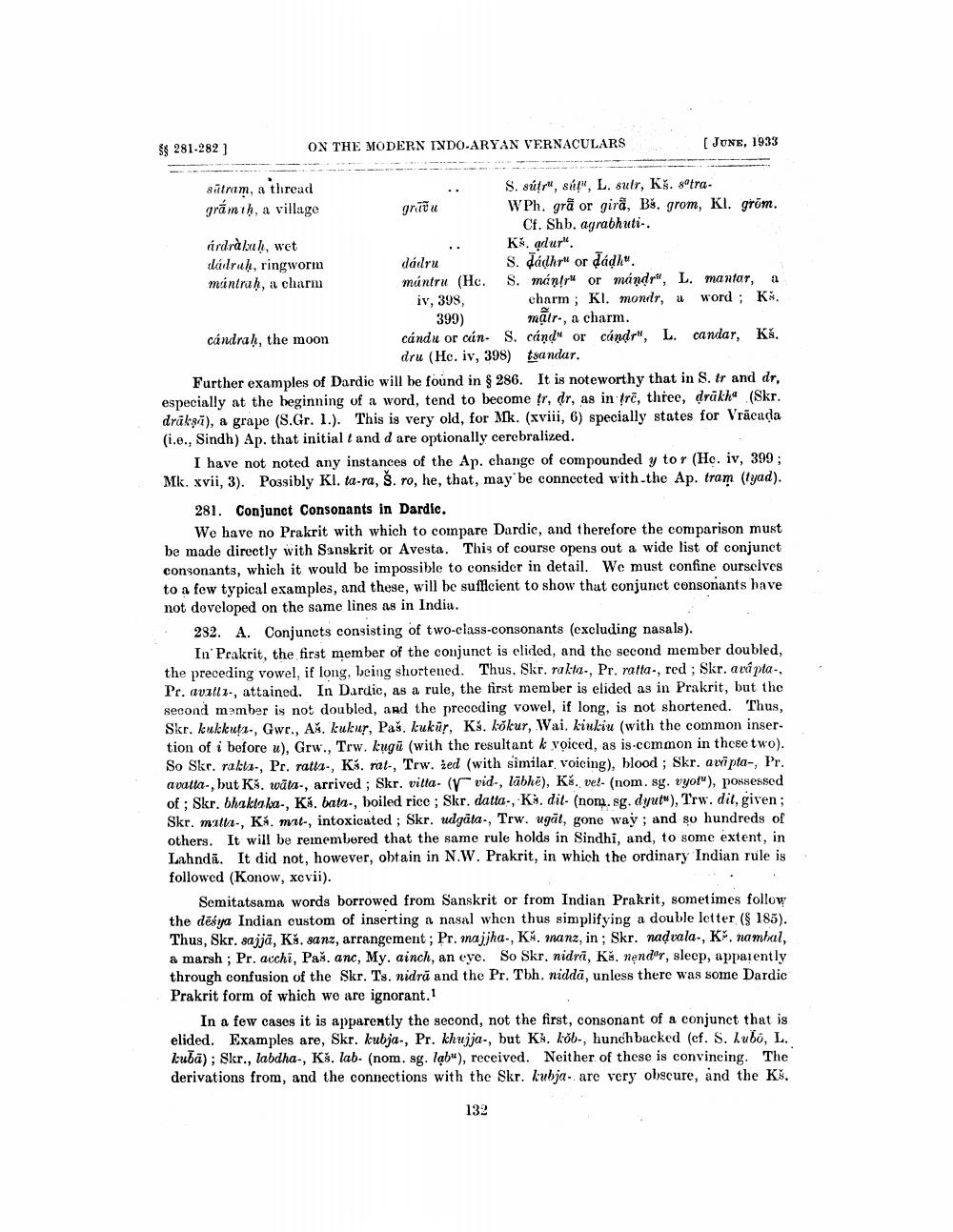________________
$$ 281-282]
ON THE MODERN INDO-ARYAN VERNACULARS
[JUNE, 1933
sutram, a thread
$, sú rể, sát, L. salr, Kp. stra. grámih, a village
grūču
W Ph. grå or girã, Bš. grom, Kl. grām.
Cf. Shb, agrabhuti. árdràlth, wet
Kadur. cládruh, ringworm
dádru
S. Jádhra or dádla. mantrah, a charm
múntru (Hc. S. mántru or mándr", L. mantar, a iv, 398, charm; Kl. mondt, word; Ki.
399) mâtr., a charm. candrah, the moon
cándu or cún. S. cand or cándr", L. candar, Kš.
dru (Hc. iv, 398) tsandur. Further examples of Dardie will be found in $ 286. It is noteworthy that in S. Ir and dr, especially at the beginning of a word, tend to become fr, dr, as in trē, three, drākke (Skr. drāksī), a grape (S.Gr. l.). This is very old, for Mk. (xviii, 6) specially states for Vrācada (i.e., Sindh) Ap. that initial t and d are optionally cerebralized.
I have not noted any instances of the Ap. change of compounded y tor (He. iv, 399; Mk. xvii, 3). Possibly Kl. ta-ra, s. ro, he, that, may be connected with the Ap. tram (tyad).
281. Conjunct Consonants in Dardic.
We have no Prakrit with which to compare Dardic, and therefore the comparison must be made directly with Sanskrit or Avesta. This of course opens out a wide list of conjunct consonants, which it would be impossible to consider in detail. We must confine ourselves to a few typical examples, and these, will be sufficient to show that conjunct consonants have not developed on the same lines as in India.
232. A. Conjuncts consisting of two-class-consonants (excluding nasals).
In Prakrit, the first member of the conjunct is elided, and the second member doubled, the preceding vowel, if long, being shortened. Thus, Skr. rakta., Pr. ratta., red ; Skr. avápta, Pr. avalli-, attained. In Dardic, as a rule, the first member is elided as in Prakrit, but the second member is not doubled, and the preceding vowel, if long, is not shortened. Thus, Skr. kukkuti., Gwr., AX. kukur, Paš. keukūr, Ks. kókur, Wai. kiukiu (with the common inser. tion of i before u), Grw., Trw. kugū (with the resultant k voiced, as is common in these two). So Skr. rakta-, Pr, ratta-, Ks. ral-, Trw. ied (with similar voicing), blood ; Skr. arvipta-, Pr. avatta-, but Kš, wala, arrived ; Skr. vitta (r vid-, lābhe), Kš. vel- (nom. sg. vyofu), possessed of ; Skr. bhakta ka-, Kš. batz-, boiled rice; Skr. datia., Kg. dit- (nom.sg. dyut), Trw. dit, given; Skr. matt-, Ki mit-, intoxicated; Skr. udgāta., Trw. ugat, gone way; and so hundreds of others. It will be remembered that the same rule holds in Sindhi, and, to some extent, in Lahndā. It did not, however, obtain in N.W. Prakrit, in which the ordinary Indian rule is followed (Konow, xcvii).
Semitatsama words borrowed from Sanskrit or from Indian Prakrit, sometimes follow the dēśya Indian custom of inserting a nasal when thus simplifying a double letter ( 185). Thus, Skr. sajja, Kš, sanz, arrangement; Pr. majjha., K. manz, in; Skr. nadvala., K. nambal, a marsh ; Pr. acchi, Paš. anc, My. ainch, an eye. So Skr, nidri, Kš, nendør, sleep, apparently through confusion of the Skr. Ts. nidrā and the Pr. Tbh, niddā, unless there was some Dardic Prakrit form of which we are ignorant.1
In a few cases it is apparently the second, not the first, consonant of a conjunct that is elided. Examples are, Skr. kubja., Pr. khujja-, but Ks. kob., hunchbucked (cf. S. Lubo, L. luba); Skr., labdha-, Ks. lab. (nom. sg. lab), received. Neither of these is convincing. The derivations from, and the connections with the Skr. kubja. are very obscure, and the Kš.
132




